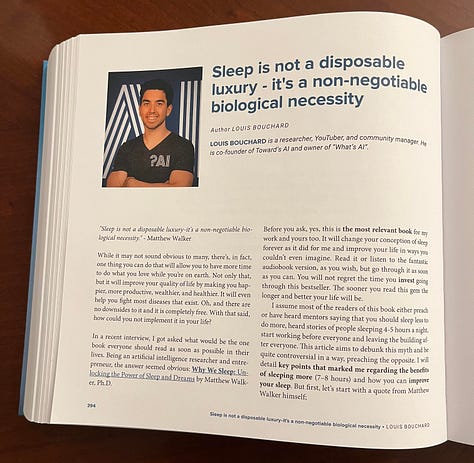Stable Video Diffusion (SVD) Explained
+ I am one of 150 authors of a fantastic book!
Good morning fellow AI enthusiast! This week's iteration focuses on the new Stable Video Diffusion model! It is an amazing open-source video generation model based on the stable diffusion (latent diffusion) architecture but for video generation. We dive into how it works 😎
I also share very exciting news: I was one of many authors of an amazing free book, "Doers and Dreamers". 📚
We conclude the iteration with a captivating short article by Auxane Boch, our favorite AI ethicist, about the ethics of emotion recognition with physiological signal sensors.
1️⃣ Stable Video Diffusion (SVD) Explained
Recent powerful image generation models like DALLE and Midjourney share a common foundation: diffusion. These models, known for their high computing demands and extensive training, are the gold standard in various image tasks. They excel not only in text-to-image transformations, as seen with DALLE, but also in advanced applications such as image inpainting, style transfer, and super-resolution.
A game-changer in this domain has been the advent of latent diffusion, especially with the introduction of stable diffusion, which has revolutionized image generation.
However, today's focus shifts to an even more groundbreaking development: Stable Video Diffusion by Stability AI.
This latest, open-source video generation model marks a significant leap forward. Capable of converting both images and text into dynamic videos, it offers an array of possibilities, including the generation of multi-view perspectives, giving a 3D-like experience.
Let's dive into how Stable Video Diffusion (SVD) works and how they were able to adapt the original powerful Stable Diffusion image generation model to work with videos! Read the article or watch the video:
2️⃣ I am one of the (150!) amazing authors of Doers and Dreamers!



I am one of the (150!) amazing authors of Doers and Dreamers.
"Doers and Dreamers is a (non-profit) anthology written by 150 "inspiring impact makers", who've turned ideas into reality and impact. It's an anthology to contribute to more commitment, more tackling, more now.
"I have had the luck to write on two topics extremely close to my heart: AI and well-being. The first shares how I am trying to make AI more accessible to everyone, and the second is on the importance of sleeping and taking care of your body and mind even as entrepreneurs (highly inspired by Matthew Walker and his amazing book).
If you want to read my parts, I have two "insights", article-like, on pages 305 (Making AI Accessible) and 394 (Sleep is not a disposable luxury - it's a non-negotiable biological necessity".
It's incredible to be featured along with humans I truly admire, like Seth Godin, Tim Ferriss, Abhishek Vijayvargia, Matt Mullenweg, Andreas Ehn, and, well, 144 other incredible "doers".The eBook is free to download for everyone. The book can also be bought in printed form on the website. Any profits from this printed version will be donated 100% to Doctors Without Borders. You can get it here:
Many thanks to Jonathan Løw for pulling all this together into this amazing, insight-packed book.
3️⃣ AI Ethics with Auxane
Decoding the Ethics of Emotion Recognition Technology: Physiological Signal Sensors Edition
Hey there, Fellow AI Enthusiasts!
Can you imagine a world where technology can decipher your emotions simply by analyzing your heart rate, skin conduction, and brain waves? It's mind-boggling, right? But along with this breathtaking concept comes a crucial challenge: addressing the ethical considerations head-on.
Privacy takes center stage in ethical use. The sensors that capture our physiological signals hold intimate data about our bodies. It's absolutely vital to protect this information from any unauthorized access or misuse. Striking the delicate balance between collecting valuable data and safeguarding privacy is paramount.
Informed consent is another crucial piece of the puzzle. When we embark on using physiological signal sensors for emotion recognition, individuals must have a crystal-clear understanding of how their data will be collected, stored, and utilized. Consent should be well-informed, voluntary, and revocable, ensuring that individuals retain full control over their personal information.
Now, let's talk also about fairness. It's absolutely critical that the algorithms behind emotion recognition are developed and trained using diverse and representative datasets. We must steer clear of biases based on race, gender, or any other protected characteristics. Ensuring fairness in algorithmic outcomes is a powerful way to prevent discrimination and promote equal treatment for all, and that’s the goal!
Emotion recognition technology holds incredible potential, but we must navigate its ethical landscape with utmost care. By prioritizing privacy, informed consent, transparency, fairness, responsible use, and regulation, we can harness this technology in a manner that respects individuals' rights and paves the way for a more equitable and empathetic society. Read More Here!
If you have any questions or thoughts, feel free to reach out!
Until next time,
Auxane Boch (TUM IEAI research associate, freelancer)
And that's it for this iteration! I'm incredibly grateful that the What's AI newsletter is now read by over 14,000+ incredible human beings and counting. Share this iteration with a friend if you learned something new!
Looking for more cool AI stuff? 👇
Looking for AI news, code, learning resources, papers, memes, and more? Follow our newsletter at Towards AI, which is going out weekly!
Looking for other AI enthusiasts? Join my Discord community: Learn AI Together!
If you need more content to go through your week, check out the podcast!
Please reach out with any questions or details on sponsorships, or visit my Passionfroot profile to see my offers.
Thank you for reading, and we wish you a fantastic week! Be sure to have enough rest and sleep!
Louis-François Bouchard



